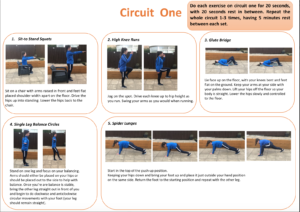Common posture mistakes

Here Lauren Lyndon- Hill Keheren Therapies Sports Therapist talks about common posture mistakes when working from home, how to avoid them and some simple tips on treating them.
Many people experience pain in their necks and upper backs as a result of craning forward while sitting to look at a computer monitor or phone display. Although it’s tempting to sprawl out and watch television for hours, this can also easily throw your back out of alignment.
Many people often experience aches or pains in their lower back, either from slouching on their chair at their computer desk, to allow their feet to touch the ground. However, sitting upright and placing something under your feet to prevent you from slouching can be a easy solution to stop this occurring.
That uncomfortable feeling of stiffness when you finally do move or stand up is telling you something.
Common mistakes
Slouching in a chair
This strain may increase tension in the muscles, which may in turn cause pain. Get into the habit of sitting correctly. It may not feel comfortable initially because your muscles have not been conditioned to support you in the correct position.
Solution:
Sitting upright and placing something under your feet to prevent you from slouching can be a easy solution to stop this occurring.
Hunched back
Hunching over your keyboard is usually a sign that you have a tight chest and a weak upper back. Over time, this type of posture can contribute to you developing a rounded upper back, which can cause shoulder and upper back stiffness.
Solution:
- Gently lengthen your neck upwards as you tuck in your chin
- Chest stretches (doorway stretch).
Poking your chin
Poking chin posture can be caused by sitting too low, a screen set too high, a hunched back, or a combination of all 3.
How to correct a poking chin:
- gently lengthen your neck upwards as you tuck in your chin
- bring your shoulder blades down and back towards your spine
- pull in your lower tummy muscles to maintain a natural curve in your lower back
- Adjust you’re seating
Rounded shoulders
A way to tell if you have rounded shoulders is to stand in front of a mirror and let your arms hang naturally by your sides. If your knuckles face forward, it may indicate that you have a tight chest and a weak upper back, giving the appearance of rounded shoulders.
Solution:
- Keep reminding yourself to sit upright, bring those shoulder back and relax (remind yourself by putting notes around your office).
- Stretch the chest (doorway stretch)
Cradling your phone
Holding your phone handset between your ear and shoulder places strain on the muscles of the neck, upper back and shoulders. The neck and shoulders are not designed to hold this position for any length of time. Could lead to muscle imbalances between the left and right side of your neck.
Exercises for neck stiffness and pain:
- Chest stretch- doorway stretch.
- neck stretches – gently lower your left ear towards your left shoulder; hold for 10 to 15 deep breaths, then repeat on opposite side
- neck rotations – slowly turn your chin towards 1 shoulder; hold for 10 to 15 deep breaths, then repeat on opposite side
Sitting in one position too long
Sitting in one position for too long can often cause aches and pains, so it is important to come away from your computer desk on a regular basis, move around and stay active or have a stretch, and then return to complete some more work.
Solution:
Have regular breaks, for example, move around the house, make yourself a tea or coffee, have a stretch or get some fresh air.
Pressure on Elbows
Leaning on your elbows can often cause pain, irritation and inflammation. Regular pressure on the elbows can cause elbow bursitis, which is a thin, fluid-filled sac that is located at the bony tip of the elbow to become inflamed.
Solution:
Elbows should be in line with the torso without putting too much pressure on the armrests and without having to reach for the keyboard and mouse.
Tips on how to maintain back posture
Stay active
One of the most important things you can do is to keep moving and continue with your normal activities as much as possible. Although you may be working from home, its important to take regular breaks to help with posture, reduce pain and also increase concentration levels.
Change your position regularly
Have regular breaks, for example, move around the house, make yourself a tea or coffee, have a stretch or get some fresh air.
Use a support
Placing a rolled-up towel or special lumbar pillow at the base of your spine while sitting will help you remember to sit up straight and provide you with some stability.
If your chair is too high, but your feet are not evenly on the ground, use objects (books or box) to ensure your legs are bent in a ‘L’ position. This is to ensure the strain is taken away from your lower back.
Pain present now?
Apply ice: Cold helps reduce inflammation that may be affecting your back. Leave the ice pack on for about 10-15 minutes, and then remove it. You can do this every 3-4 hours.
Use a heating pad: After any inflammation is under control (about 24 hours or so), many people find heat soothing. It also promotes healing by bringing blood to your back.
If you have a question for Lauren or would like to book an online sports therapy assessment please email lauren@keherentherapy.co.uk


